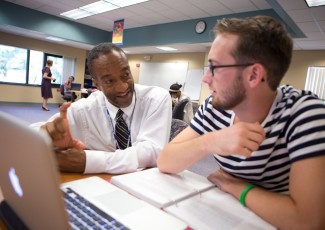Supporting Transfer Students From Start to Finish
By Emily Rogan
October 23, 2015
Programs at one New York college help keep students on the path to a four-year institution.
Onondaga Community College (OCC), in Syracuse, New York, has long been a place that prepares students for transferring to four-year institutions. Part of the State University of New York (SUNY) system, Onondaga has transfer agreements with more than 80 colleges and universities, and more than 60 percent of the college’s students are enrolled in some form of transfer program. We took a closer look to find out what programs work to help students get from orientation to successful transfer.
Transfer programs that work
Historically, OCC students have received a strong liberal arts foundation, in preparation for transfer to four-year institutions, says Julie White, vice president of student engagement and learning support. In recent years, administrators haven taken things one step further with increased services to better support students along the way:
- Created a central information center: OCC established a visible and accessible transfer center within the main student center. There, students can research schools they might consider. The center also offers peer leaders, who are supervised by the transfer coordinator, to help students complete the Common App or the SUNY application.
- Arranged to have college reps visit campus: OCC established an adviser-in-residence program, in which representatives from four-year colleges or universities visit the OCC campus on a weekly basis. They answer questions about their institutions, look at students’ transcripts and help students distinguish which school might be the best fit.
“[Four-year institutions] know that students who transfer from community college are retained at a higher rate and do as well as their native students,” White says. “They are very eager to have our students when enrollments are challenging.”
Another reason colleges seek OCC transfer students, according to White: “Our students are road-tested. They’ve figured out strategies to put in place. They’ve learned how to ask for help.”
- Information about transferring is available:
- At orientation, students take a workshop on transferring and learn about the adviser-in-residence program.
- Each semester, 60 colleges and 300 students participate in a transfer fair at the student center.
- Students can visit nearby transfer institutions with organized campus tours.
- Regular workshops, both stand-alone and in class, are held to talk about transfer opportunities and application completion.
Lessons to keep in mind
Constant dialogue between OCC and partner institutions is essential for 2+2 transfers (when a student is admitted simultaneously to OCC and the four-year institution) and articulation agreements (when courses are accepted toward majors, but students must apply to the four-year institution) in order to best support students, White says.
“We can tweak our curriculum or modify a course based on the feedback from the four-year school,” she says. A strong relationship between the faculties of both schools is important for smoother transfer pathways, White adds.
Also, keeping students focused on their transfer goals is essential, White says. “It can seem far away, so keeping it in their minds is important.”







